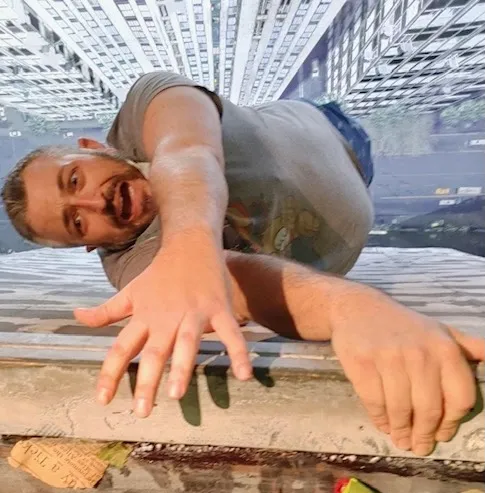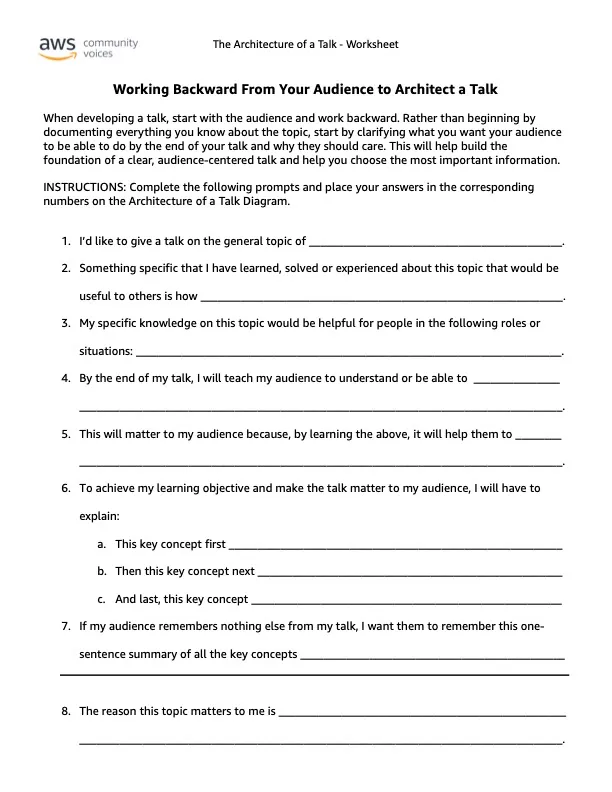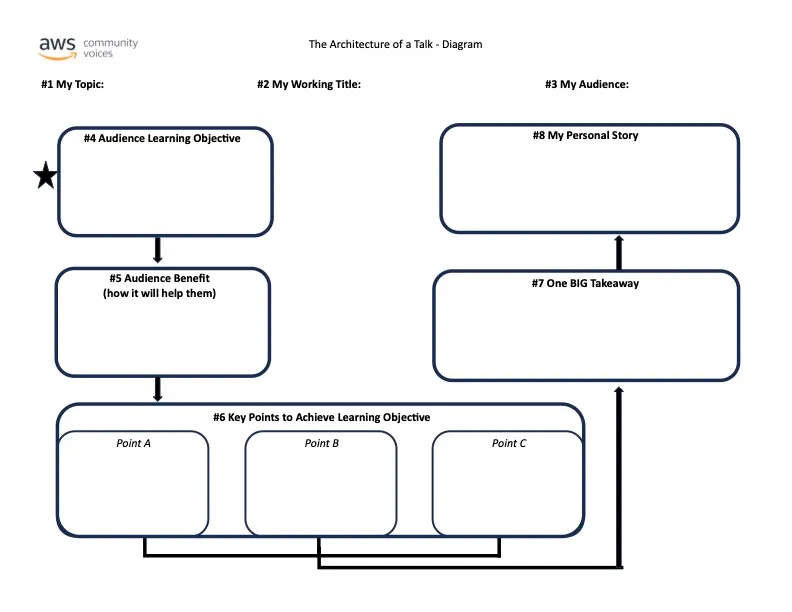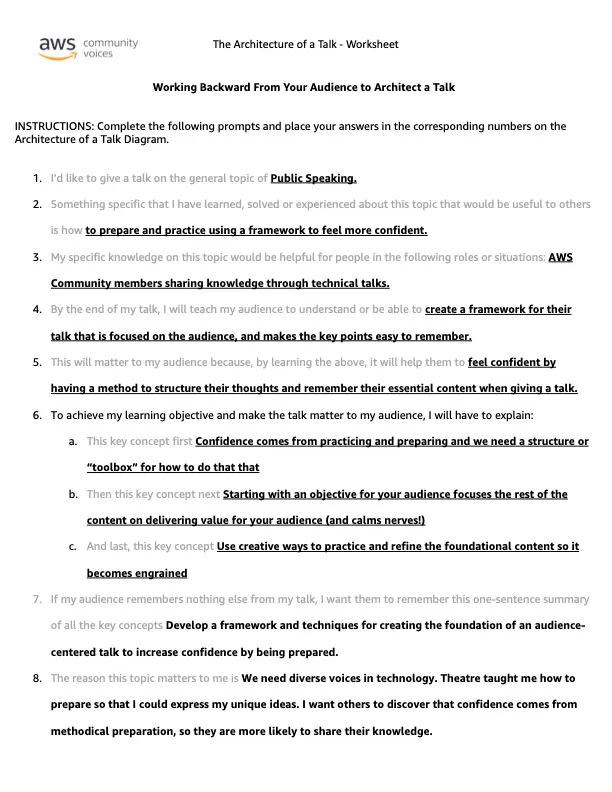The Architecture of a Talk
An activity guide to building the foundation of an audience-centered talk. (This can also be used as a workshop in communities.)
Mark Pergola
Amazon Employee
Published May 6, 2024
Last Modified May 8, 2024
This blog outlines a framework to build the foundation of a presentation for any audience. It's also an activity guide you can facilitate in your communities to help others gain confidence as public speakers. This "Architecture of a Talk" process is inspired by AWS community members who contributed to the AWS New Voices speaker training program and have mentored others through coaching.
*This blog and activities were written by me. Generative AI from Amazon Bedrock helped edit my writing to be more concise without altering my original thoughts.
"Your number one task as a speaker is to transfer into your listeners’ minds an extraordinary gift—a strange and beautiful object that we call an idea." - Chris Anderson, Head of TED Talks
Imposter syndrome is real, and sadly it keeps some of the most interesting, diverse voices from stepping on stage. We all learn and experience the world differently. You should still give a talk sharing your knowledge, even if a hundred other people are talking about the same thing. You will share it how you experienced and understood it, and someone will need to hear that. In this video from AWS Hero Ivonne Roberts, she gives sage encouragement for just this thing. But still, if you are like me, being asked to give a talk can feel a little like this:

There's endless advice out there for speakers, which is very helpful but also overwhelming. Beginning speakers often ask: "How can I improve my confidence and not be so nervous?" In working with newer speakers, I usually find there are two areas of uncertainty fueling this question:
- How to prepare a talk in a way that is focused on the audience, but easy to remember
- What information to present and what to leave out
I see many speakers begin building a talk by brain-dumping everything they know creating death-by-information. You never want your audience asking themselves "why are you telling me this?" So, to help work backward from an audience, I've crafted a simple set of activities to help you make it all about them.
This blog is also a workshop you can facilitate. It has the following components with guidance for facilitators:
- Building the Architecture of Your Talk
- Ask the Expert: A game to clarify your talk
- Videos to help you transform your architecture into a complete talk
Before working in tech, I had a career in theatre and education. I'll never forget my first experience onstage. I was a terrified high school freshman who had just moved to a new school in a new town. For a final test in Shakespeare class we had to perform monologues. I was SO nervous. I spent hours practicing the lines, mapping movements and rehearsing different emotions.
Every time I rehearsed, two things happened: I discovered something new or something to change and the performance got more engrained in my memory.
When it was time to perform the monologue, I stepped on stage and was shaking so bad I figured everyone noticed. I had rehearsed enough times that, despite being terrified, muscle-memory took over. All that rehearsing had created a roadmap of what I was there to do, and that began to calm me down. At the end, I was surprised that the audience applauded and my performance had actually made sense.
The performing arts teaches us the art of preparing and rehearsing. Behind magical performances are tactical approaches like a script, notes of where to move and mental bullet points that you've reviewed a thousand times while doing your daily activities. Rehearsing helps us continually clarify and distill down to what is best for the audience.
If you wait to feel totally confident before you get on stage and share your knowledge, it will never happen. The secret of the pro's is that they use techniques to ground and prepare them, and then they do it despite feeling unconfident. The formula is simple:
The exercises in this blog, which you can also facilitate in your communities, are what comes before polishing your presentation with slides, captivating hooks and compelling data. This is your foundation so that you are clear how you are serving your audience and scaffolding the bones of your talk under that focus, and you always know the roadmap of your content. At the end of this blog, I suggest a couple resources to fully craft your presentation.
Below are the steps to creating The Architecture of a Talk. This is your simple, foundational roadmap for your content on which you can build full presentations, video scripts and more. I also provide examples of the completed worksheet. At the end, there are suggestions for fun activities to rehearse your architecture after you've completed it. In each section, I will also provide guidance for facilitators.
Many of these principles are borrowed from what I have learned from the best teachers. Great teachers focus on clear learning outcomes and scaffold activities and information in the right sequence to help students reach that objective. And then they insert creativity and interactivity into the steps so that learning is engaging. I always tell speakers: focus on teaching. When you do that, you focus on making sure you are clear, you choose information that matters and you make it about providing value to your audience rather than what you want to say about yourself.
Below is the worksheet to complete the diagram. You are welcome to download and print/use these. It has several prompts in a deliberate order to guide you in creating a talk from your unique knowledge focused on delivering for your audience. You will complete the prompts, and put your answers in the corresponding numbered section of the diagram. The idea is to build everything based on what you want your audience to achieve.

Here is the diagram where you will put your answers once they are final.

Here is an example of my completed worksheet from when I delivered this as a workshop to the AWS Community in Singapore on May 6, 2024.

If you are facilitating this activity with a group:
- Encourage participants to choose any topic for the workshop, especially fun, lightehearted or passion topics. Sometimes, practicing on a topic that won't likely be your next technical talk makes it easier to learn the process.
- Give at least 40 minutes. This can take up to 75 minutes if you stop and have participants share and get feedback on each step.
- Have the group do it in steps - maybe 2 prompts at a time
- Consider partnering participants so they can bounce ideas off each other/get feedback
- The other way to facilitate group learning is to stop after every 2-3 prompts and have some volunteers share what they've written.
- This gets the group speaking in front of each other early, and throughout the workshop.
- This also helps everyone understandin the process through examples
- Give helpful feedback to those who volunteer to make their points stronger.
- This can be done multiple times - don't make participants feel like they are locked in to their answers. As the talk develops and they prepare, the architecture might change
- Have a discussion:
- What did you notice?
- What was challenging?
- What was surprising?
- What feels clearer?
This is an activity to begin speaking extemporaneously using your architecture, and to get feedback on if your key points are strong and make sense. Getting feedback in the form of questions tells us a lot about what's resonating and what's missing or unclear. You will need a partner: a loved one, a colleague, your local barista (make sure to tip!). You will:
- Speak for 5 minutes exactly, no more or less (set a timer)
- Focus on your learning objective, and try to teach that objective using your Key Points and One Big Takeaway from the architecture. Incorporate as many elements form the architecture as you can including why this will benefit the person you're speaking to and why it's personal for you.
- When you finish, your partner can ask you questions that begin in the following ways:
- “Help me understand…?”
- “Will you tell me more about…?”
- “What if…?”
- Answer their questions and see where it leads. Take notes on anything you discovered might be missing from the sequence of your Key Points, One Big Takeaway or Audience Objective. Update your architecture as needed.
- You can also do this by inviting volunteers to speak in front of the group and take questions from the other participants. Make sure to ask them what they heard and would change from the questions in front of others so everyone benefits from the learning.
If you are doing this as a longer workshop, this makes a great second activity after the architecture. Or, you could do this activity separately as a follow up session after doing the architecture process. To facilitate this activity:
- Set a time limit. Something like:
- 5 minutes to speak
- 5 minutes for questions from your partner
- 5 minutes to take notes/update your architecture.
- Switch speaker/listener
- Depending on available time, invite 1-3 brave individuals to come up and do this in front of the group. Have the audience ask questions using the prompts. (You can do this before breaking into smaller groups as an example, or after participants have worked with their partners as a showcase.)
- Have a discussion
- What did you discover?
- What was working in your talk?
- What needed to change?
- What surprised you about what the audience did or didn't hear?
Again, there are MANY tips and lessons on how to structure and deliver a polished talk. To help you begin, here are a few videos:
- This video from AWS Developer Advocate Brandon Carroll (A great speaker and generous human!) gives great tips on building your presentation, including sequence and time breakdowns for each section.
- These three videos of technical talks given by AWS Heroes at AWS re:Invent 2023 are stellar examples of talks with all the components of the architecture.
- Dave Stauffacher: Automating a 20 TB file server migration
- AJ Stuyvenberg: Demystifying and mitigating AWS Lambda cold starts
- Last, I highly recommend speaker coach Meridith Grundei. She also trained in theatre and the famous Second City Improv, and has coached technical speakers at AWS re:Invent. I've learned a lot from her, and she helped train AWS community speakers through our New Voices program. Here's her YouTube channel.
I hope this encourages to share your knowledge by giving a talk at your local user group, community event or even to colleagues in your company. Additionally, I hope you share and facilitate these activities in your groups to build connections and confidence. Speak up!
Any opinions in this post are those of the individual author and may not reflect the opinions of AWS.
